You may never have heard of this issue's interviewee but chances are that you're one of the millions who've seen his work. Alexis Wajsbrot is a technical director at the Moving Picture Company in London. He's worked on a number of high-profile films including Harry Potter and the Half-blood Prince, Harry Potter and the Order of Phoenix, Tim Burton's Sweeney Todd, and also on some of those visually stunning commercials you see while waiting for your film to start. Currently Alexis is helping to produce film versions of the video game The Prince of Persia, due out in 2010, and the American action toy series GI Joe: The rise of Cobra, scheduled for release in the beginning of August.
Alexis' specialty is anything that behaves like a fluid: water, fire, air, smoke, snow, even fur, or cloth. "In Harry Potter and the Order of Phoenix I worked on the [Voldemort-trapping] sphere of water and the fire serpent," he says, "and in Sweeney Todd I worked on a dream sequence with a swaying tree in a garden. I also did the grass, the fur of rats, and blood. In GI Joe I'm doing lots of underwater explosions, and my favourite project on The Prince of Persia is a sand storm." Alexis' job is to turn the director's vision of these dynamic elements into movie reality, and so he's perched right on the boundary between art — creating the dramatic effect — and science and technology — using programming and maths to simulate nature on computers. (Click on the image below to see a movie of Alexis' work, but beware — it's a 18MB file.)
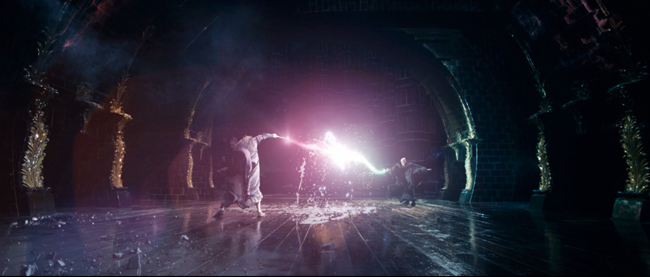
A scene from Harry Potter. Click on the image to play a movie of Alexis' work in another window. Warning: it's a 18MB file.
The tools of Alexis' trade are sophisticated software packages that have components specially designed for fluid animation. A lot of research is currently going into developing these fluid solvers, and technology in this area is moving fast. On his latest projects Alexis has been using a combination of several packages, including Maya, Realflow and Flowline. All are based on a combination of two approaches that are currently considered the best in fluid modelling. Just how you go about creating a scene depends on which of the two approaches you choose to take.
A scene is born
The first approach is to approximate the liquid, fire, smoke, snow, or whatever you might be dealing with, by a large number of particles moving around in a 3D co-ordinate system. The software allows you to choose how, and at which rate, the particles are emitted in your space, and you can control their speed. You can then determine what kind of forces or acceleration they should be subject to. For example, in the clip below (click on the image on the left to see it in another window) particles are emitted from a central point and they're shooting straight up, until they hit a gravity field — an area where the user has stipulated that gravity should be acting on them — so they fall straight down, in what might be the first step in a simulation of a fountain. This clip was created in a matter of minutes using Maya. The image on the right shows what the simulation looks like in the Maya interface — the green box is the region in which gravity acts on the particles.
 Click on the image to play the movie in another window. |
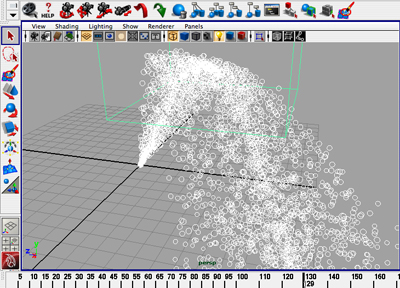 A view of this scene in the Maya interface. |
The particles here still look pretty crude, but you can do a lot simply by asking the software to change their shape. In the second clip below particles are also emitted from a central point, they're shooting right up, but this time there's no gravity field. Instead, the particles have been enlarged and rendered as semi-transparent spheres, creating what resembles a plume of smoke.
 Click on the image to play the movie in another window. |
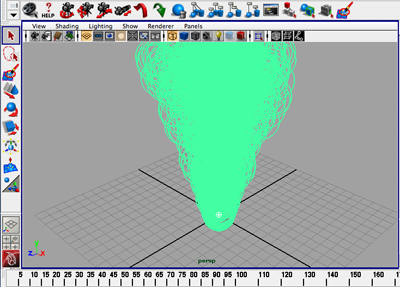 A view of this scene in the Maya interface. |
In the third clip particles are emitted horizontally from a central point and eventually hit a gravity field. Some viscosity has been added and they've been rendered to resemble powder or sand.
 Click on the image to play the movie in another window. |
 A view of this scene in the Maya interface. |
Gravity and viscosity aren't the only physical forces and effects that can act on the particles. The software can also implement turbulence, wind, vortices and more. The user can determine the strength and direction of these effects, as well as the physical properties of the particles, and the software then works out just how the particles should react. They can be rendered in all sorts of different shapes, as points, streaks, bubbles, in fact you can import any shape you choose. Colours, lighting, and other artistic tools can be used to build up a realistic looking scene.
The second approach to fluid simulation doesn't track the movement of particles, but divides the volume containing the fluid into a 3D grid of cells called voxels (from the words volume and pixel). Each cell is stored in the computers' memory with numerical information describing the velocity — the speed and direction — of the fluid motion in that voxel at the start of the scene. Taking into account the forces and effects the user has chosen to add to the scene, the software then uses the mathematics of fluid dynamics to calculate the velocity in each vortex at the next time step, and keeps going until the end of the scene. The resulting motion is visualised on the screen by a process that's akin to pouring powder into a liquid. You can emit your powder, which is properly called density, anywhere in the region that contains the fluid, and it then diffuses and moves around as dictated by the velocities in the voxels at each time step. For example, the clip below shows density being emitted from a central point. It diffuses and moves upward, until it hits the ceiling of an invisible container and starts to drift down, creating what looks like an explosion, or smoke being emitted in the centre of a room.
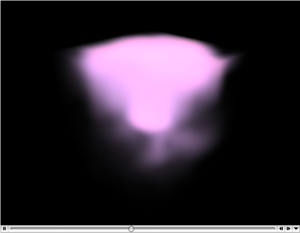 Click on the image to play the movie in another window. |
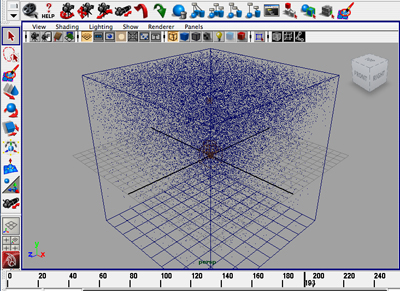 A view of this scene in the Maya interface. |
Different types of forces and physical effects can be made to act on the density, and artistic tools can be used to render a realistic scene. In the clip below, density is emitted from a central point in all directions, a little turbulence has been added, and the whole thing has been rendered as something looking like foam.
 Click on the image to play the movie in another window. |
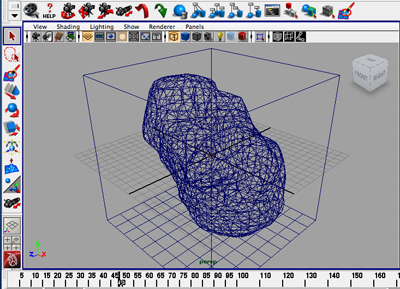 A view of this scene in the Maya interface. |
The ocean surface in the clip below was produced using one of Maya's built-in functions.
 Click on the image to play the movie in another window. |
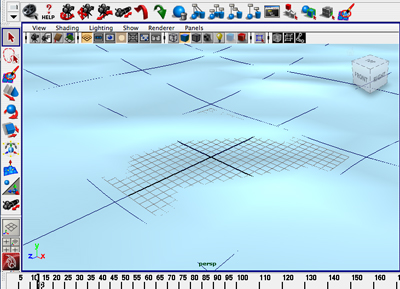 A view of this scene in the Maya interface. |
"To do the water sphere in Harry Potter and the Order of Phoenix, we first modelled a sphere and then converted it into a fluid by emitting density and velocity [from its surface]," says Alexis. "In this way the sphere becomes a voxel-based dynamic object, rather than a geometric one. It looked a bit blobby at first, so to make it more realistic we emitted particles from the fluid. The software [in this case Flowline] is just astonishing: when there is a wave in your fluid, you can get it to emit particles — the higher the velocity, the more particles the wave emits. These particles become the spray of the waves, and when they hit the water they can be turned into bubbles." By tweaking parameters like the viscosity and buoyancy of the particles/fluid, all these effects combined can be rendered to produce the amazingly realistic scenes you see in the cinema.
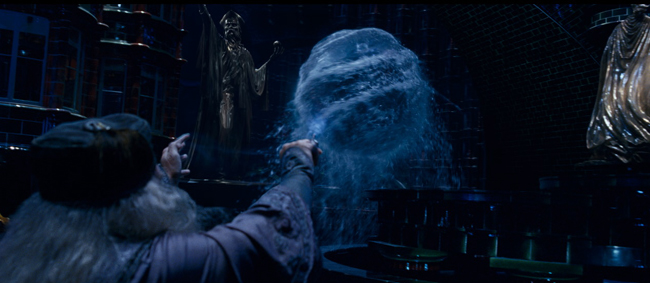
The water prison from Harry Potter and the Order of Phoenix.
From scene to movie
The clips above only took a few minutes to produce and they are of course a long way off Alexis' water sphere, or anything else that would make it into a movie. Creating the real thing takes a lot of expertise in using the complicated software and an incredible amount of tweaking and tinkering. "We spent six months to simulate a 30 second water sphere scene [for Harry Potter and the Order of Phoenix], and it took me almost two months to create an underwater explosion for GI Joe," says Alexis.

Alexis animated the tree in Sweeney Todd.
Often a whole string of people is involved in the creation of one particular object or character. "To do something like a rat in Sweeney Todd, you first need someone to model the rat, then you need someone to 'rig' the rat, that is to equip it with a skeleton, sometimes someone will then also put a muscle system on the skeleton, and another person then animates the rat. Then it's my turn, putting on the fur, after that someone will render it using the correct lighting and so on, and finally yet another person will integrate the rat into the scene." (See Plus article It's all in the detail to find out more about this process.) With all this effort just for a rat, it takes a lot of visual effects people to create a whole movie. "The Harry Potter movies had about 100 people from my company alone working on them, and there were another two companies involved," says Alexis. "That's at least 300 people working for between 2 and 3 years on one movie." No wonder these films eat up such enormous budgets.
Having a large number of visual effects people milling around on the actual movie set would wreak havoc with any director's nerves, so for the moment Alexis spends most of his working time away from the set in his office. "For someone in my position there isn't really any need to be on set, but as you become more senior in the company, you'll get there more often because you have to supervise how the visual effects will be integrated and speak to the director about what it is he or she wants. Sometimes the director does come and see us though, and I did get a chance to go to the Harry Potter set — that was a great experience. They have seven years' worth of sets there, it's absolutely huge, and I got to meet everyone. It's a really cool team."
How do you get there?
But despite the lack of frequent movie-star contact, Alexis' work will probably seem like a dream job to anyone who loves movies, design and computers. So how did he get there? "I studied at a school of the Université Paris 8, called Art & Technologies de l'Image. It focusses on a mix of art, maths and computer coding. Then I went to Madrid for a year, working on low budget movies and commercials — it was a great time and I learned a lot. Then I spent another three years in Paris doing mostly commercials, and then I came to London to work on Harry Potter for the Moving Picture Company. It was my first big movie and so far my favourite,"

The fire serpent from Harry Potter and the Order of Phoenix.
Mathematics is an important part of Alexis' training. Understanding 3D geometry is obviously essential, so there is a lot of vector and co-ordinate geometry. "For example, you might want to know how close your camera is to your particle or object, so you'll calculate the difference between the vectors that describe their respective locations." (See Plus article Maths goes to the movies for more on geometry in movie making). Then there are the mathematical skills needed for computer programming, and a general understanding of science to play with the physical parameters used by the software to create realistic scenes. If you're really into your maths and science, then you can go into the actual research and development of the software. "I mostly use the software and try to make the best out of it by adding plugins," says Alexis, "but the really hard maths goes into the coding of the software." To create realistic simulations of fluids, the software has to mimic the underlying physical processes as accurately as possible, by implementing the mathematical equations that describe these processes. But these equations are incredibly complex — in fact there is no complete mathematical description of fluid flow (see Plus article Births and deaths in fluid chaos). So the challenge facing programmers is not only to understand the maths, but also to figure out how to turn it into programs that don't take ages to run. It's a struggle between accuracy and efficiency.
Alexis' own work sits right on the boundary between the mathematical and the artistic side of things, and to people who are interested in going down that route he recommends to study both. "It's good to study art, to understand colours and image composition, for example. For the other part, mathematics is really the best thing to study. The better you are in mathematics, the more independent you are of the software. Everyone can do what the software can do, but with extra knowledge you can go further and use the software to do things no-one has seen before — and that's what movie companies want."
About this article
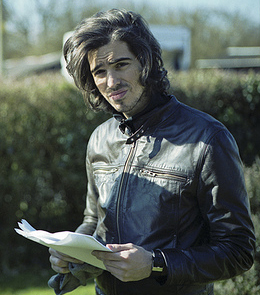
Alexis Wajsbrot was interviewed by Marianne Freiberger, Co-Editor of Plus, in London in April 2009.